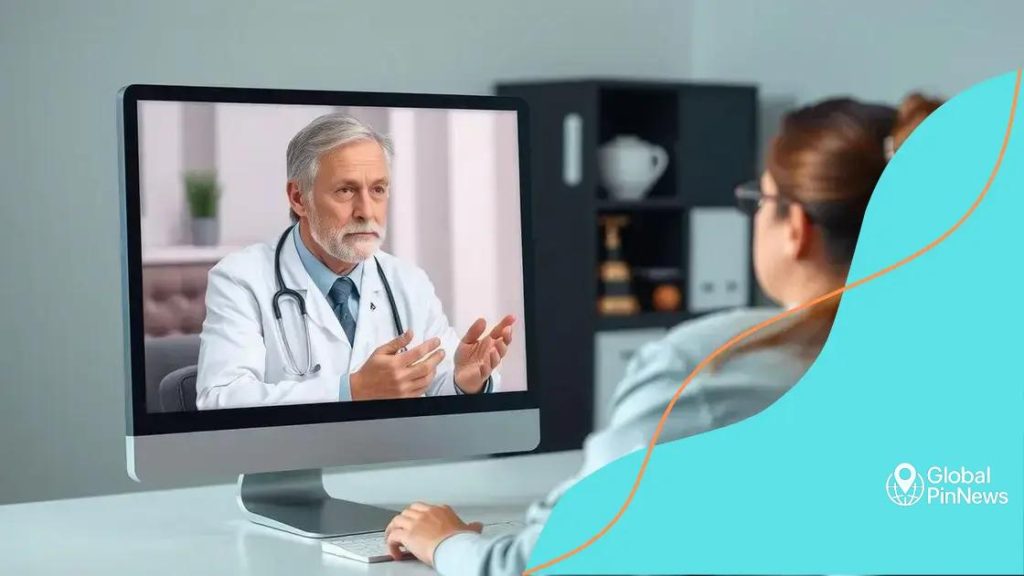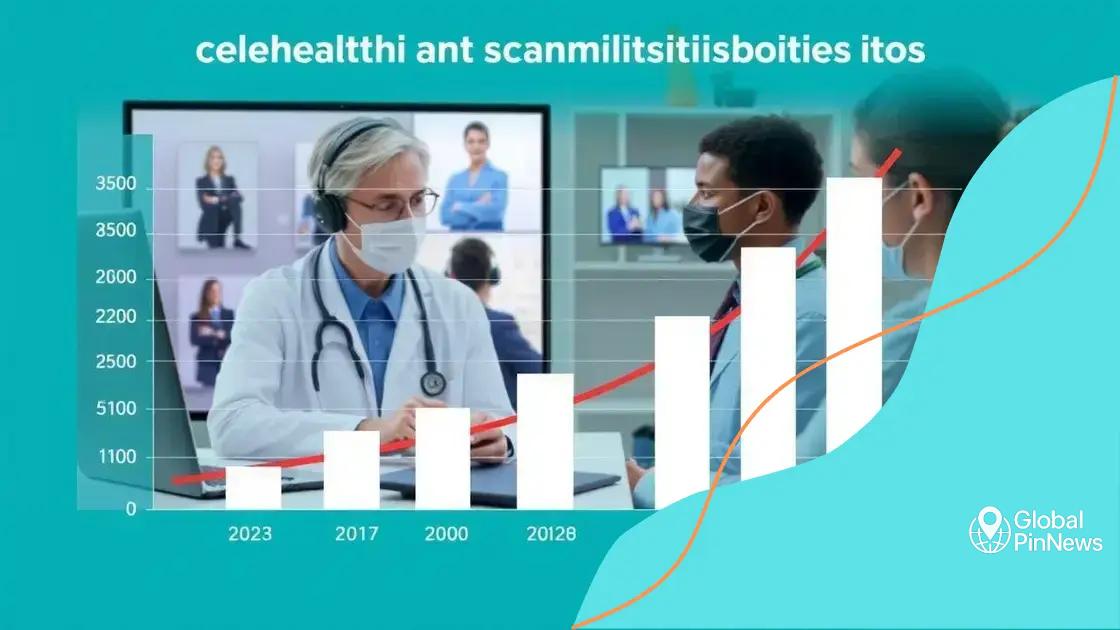Telehealth benefits utilization rates: improving access to care

Telehealth benefits utilization rates are increasing as patients appreciate the convenience, improved access to specialists, and enhanced engagement in their healthcare through virtual consultations.
Telehealth benefits utilization rates are on the rise, reshaping how we think about healthcare delivery. Have you considered how virtual appointments could make your life easier? In this article, we’ll dive into the advantages of telehealth and its growing importance in modern medicine.
Understanding telehealth and its benefits
Understanding telehealth is essential as its popularity grows. This innovative approach to healthcare delivery allows patients to connect with medical professionals remotely, making healthcare more accessible.
Many people are curious about what telehealth truly entails. It’s more than just a phone call or video chat; it includes various services like appointments, follow-ups, and even mental health support. The flexibility it offers is one of the main reasons people are embracing this method.
The key benefits of telehealth
Telehealth provides numerous advantages that can enhance the patient experience. Here are some of the key benefits:
- Convenience: Patients can consult their doctors from home, saving travel time.
- Increased access: Those in rural or underserved areas can reach specialists more easily.
- Lower costs: Virtual visits often reduce healthcare costs for both providers and patients.
- Flexibility in scheduling: Patients can book appointments that fit their lifestyles.
Moreover, the adaptability of telehealth means it can serve a variety of healthcare needs. For instance, patients can manage chronic conditions through regular check-ins without needing to visit a clinic physically. This ongoing care can lead to better health outcomes.
As more people discover the benefits of telehealth, it becomes evident that this approach is not just a temporary solution, but potentially a long-term shift in healthcare delivery. There is an ongoing conversation about the quality of care delivered virtually versus in-person. However, many studies indicate that patient satisfaction remains high with telehealth services.
Challenges to consider
While telehealth offers many benefits, it’s important to acknowledge the challenges. Not everyone has access to reliable internet or the necessary technology to engage in virtual consultations. Additionally, some patients may feel uncomfortable using digital tools for healthcare.
As the landscape of healthcare continues to evolve, understanding the fundamentals of telehealth can prepare patients for a future where virtual services play a significant role in their healthcare journey.
How telehealth improves healthcare access
How telehealth improves healthcare access is a crucial topic in today’s medical landscape. It breaks down barriers that often prevent patients from receiving timely care. By facilitating virtual appointments, patients can receive care without the stress of long travel distances.
Telehealth significantly enhances access for individuals living in remote or rural areas. These patients may have difficulty finding specialists nearby. With virtual visits, geographical barriers are reduced, making healthcare more equitable. People can now consult with top healthcare professionals from the comfort of their homes.
Key ways telehealth enhances access
Several factors contribute to the improved accessibility of telehealth services:
- Reduced travel time: Patients save hours by not needing to commute to appointments.
- Convenient scheduling: Many telehealth platforms offer flexible appointment times that fit into busy lives.
- Availability of specialists: Patients can connect with specialists who might not be available in their area.
- Lower costs: Virtual visits can be more affordable, reducing the overall cost of healthcare.
Additionally, telehealth plays a crucial role in managing chronic conditions. Patients can have regular check-ins with their doctors without the need for frequent in-person visits. This ongoing communication helps ensure better adherence to treatment plans, leading to improved health outcomes.
Moreover, telehealth also accommodates those with mobility issues or disabilities. It removes obstacles that may prevent these individuals from accessing necessary medical attention. By making services available online, healthcare becomes more inclusive.
The role of technology
The effectiveness of telehealth relies heavily on technology. As internet connectivity improves globally, more people can access these services. Using smartphones or computers, patients can engage in consultations, making the whole process straightforward and user-friendly.
As a result, telehealth continues to grow, making healthcare more accessible and allowing patients to receive the care they need, regardless of their location.
Current utilization rates of telehealth services

Current utilization rates of telehealth services provide insight into how this delivery method has gained traction in recent years. Various studies show that patients are increasingly opting for virtual consultations over traditional face-to-face appointments.
As more healthcare providers adopt telehealth, usage rates have soared. Many people appreciate the convenience and flexibility of accessing medical care from their homes. Recent surveys indicate that approximately 60% of patients have used some form of telehealth in the past year.
Factors influencing utilization rates
Several factors contribute to the current utilization rates of telehealth services:
- Increased awareness: Educational campaigns have informed patients about the availability of telehealth.
- Pandemic response: The COVID-19 pandemic accelerated the adoption of virtual visits.
- Insurance coverage: Many insurance plans now offer coverage for telehealth services, making them more accessible.
- Technological advancements: Improved technology has made it easier for providers and patients to connect online.
Additionally, studies show that the demographics of telehealth users are changing. Originally popular among younger populations, older adults are now embracing telehealth as they recognize its benefits. This shift has led to a broader acceptance and integration of virtual healthcare services into daily routines.
In many regions, telehealth usage remains high even as in-person visits resume. Patients appreciate the option to have virtual appointments for non-emergency consultations. This flexibility often leads to improved patient satisfaction as it allows for more accessible healthcare.
Looking at the data
Data illustrates that mental health services have seen particularly high utilization rates. Many patients prefer discussing sensitive issues in the comfort of their own spaces rather than in a clinic setting. According to recent reports, virtual therapy sessions have increased by 80% since the onset of the pandemic.
As we continue to analyze telehealth services, the emphasis on data will help shape future policies and practices. Understanding current utilization rates is crucial for enhancing the quality of care offered through telehealth.
Impact of telehealth on patient outcomes
The impact of telehealth on patient outcomes is a significant area of interest in modern healthcare. Many studies reveal that virtual consultations can lead to positive health results. This method allows for more frequent check-ins, enhancing patient engagement and satisfaction.
One major benefit is the timely access to medical advice. Patients who use telehealth can report symptoms and receive guidance quickly. This quick turnaround often prevents conditions from worsening, leading to better overall health.
Improved management of chronic conditions
Telehealth plays a vital role in managing chronic illnesses such as diabetes and hypertension. Patients can easily share their health data with providers in real-time. This constant flow of information enables doctors to adjust treatment plans promptly. As a result, patients tend to have better control over their conditions.
- Regular monitoring: Patients can be monitored continuously, leading to proactive care.
- Enhanced communication: Improved communication between patients and providers fosters trust and accountability.
- Personalized care: Treatment plans can be tailored more effectively based on real-time data.
- Increased adherence: Patients are more likely to follow treatment regimens when they have regular contact with their healthcare team.
Moreover, telehealth provides a supportive environment for mental health services. Patients can engage in therapy sessions from their chosen spaces, which often reduces anxiety associated with in-person visits. Many individuals report feeling more open and honest during virtual sessions, thus leading to better mental health outcomes.
Additionally, the ability to connect with specialists from anywhere significantly contributes to improved outcomes. Patients no longer have to wait for long appointments. Instead, they can discuss their issues with experts who may be miles away. This ease of access can lead to quicker, more accurate diagnoses and treatment.
Patient satisfaction and quality of care
Data shows that patient satisfaction is generally higher among those who use telehealth. Surveys indicate that many appreciate the convenience and flexibility of virtual appointments. This satisfaction often translates into better health engagement and participation in their own care.
In summary, the impact of telehealth on patient outcomes highlights the importance of integrating technology into healthcare. By facilitating communication, managing chronic conditions, and enhancing patient satisfaction, telehealth is reshaping how we view medical care and outcomes.
Future trends in telehealth utilization
The future trends in telehealth utilization are exciting and full of potential. As technology evolves, healthcare delivery is changing rapidly. Many experts believe that telehealth will become a standard part of patient care.
One growing trend is the use of artificial intelligence (AI) in telehealth. AI can help assess patient needs and streamline appointments. Through chatbots and virtual assistants, patients can find answers to their questions quickly. This can lead to more efficient care and better patient experiences.
Integration of wearable technology
Another significant trend is the integration of wearable technology into telehealth. Devices like smartwatches and fitness trackers allow patients to monitor their health in real-time. These devices can send data directly to healthcare providers, enabling proactive care management.
- Chronic disease management: Patients can track important metrics, like blood sugar levels or heart rate.
- Enhanced communication: Real-time data sharing fosters better communication between patients and doctors.
- Personalized health insights: Providers can offer tailored advice based on individual health data.
Furthermore, virtual reality (VR) is emerging as an innovative tool in telehealth. VR can provide immersive experiences for pain management, physical therapy, or even mental health therapy, enhancing patient engagement. These new tools make healthcare more dynamic and interactive.
As regulatory policies adapt, we can expect telehealth services to expand further. Insurance companies are increasingly offering coverage for these services, making them accessible to more patients. This trend helps to remove financial barriers and encourages patients to seek care when needed.
Increased patient engagement
With growing acceptance of telehealth, patient engagement is expected to improve. More people are becoming comfortable with virtual appointments, resulting in higher satisfaction. Educational resources about telehealth benefits will likely empower patients to take active roles in their healthcare.
The rise of mobile health applications also plays a significant role in this trend. These apps can provide reminders for medications, encourage healthy habits, and facilitate easy communication with healthcare teams. As patients become more involved, their health outcomes may improve.
In summary, the future of telehealth utilization looks promising. With advancements in technology, regulatory changes, and increased patient engagement, we can expect to see a transformation in how healthcare is delivered.
Conclusion: The future of telehealth is bright and full of exciting possibilities. As technology advances, its integration into healthcare will likely improve patient access and outcomes. People are becoming more comfortable with virtual health services, and this trend will only continue to grow. By embracing innovations like AI and wearables, the healthcare industry can better meet the needs of patients. Overall, telehealth is transforming how we think about and experience healthcare, making it more accessible and efficient for everyone.
FAQ – Frequently Asked Questions about Telehealth
What is telehealth?
Telehealth is the delivery of healthcare services through digital technology, allowing patients to consult with healthcare providers remotely.
What are the benefits of using telehealth?
Telehealth offers convenience, increased access to specialists, and lower costs compared to traditional in-person visits.
How does telehealth improve patient outcomes?
By enabling regular communication and real-time monitoring, telehealth helps in better management of chronic conditions and enhances patient engagement.
Is telehealth covered by insurance?
Many insurance plans are beginning to cover telehealth services, but it is important to check your specific plan for details.
